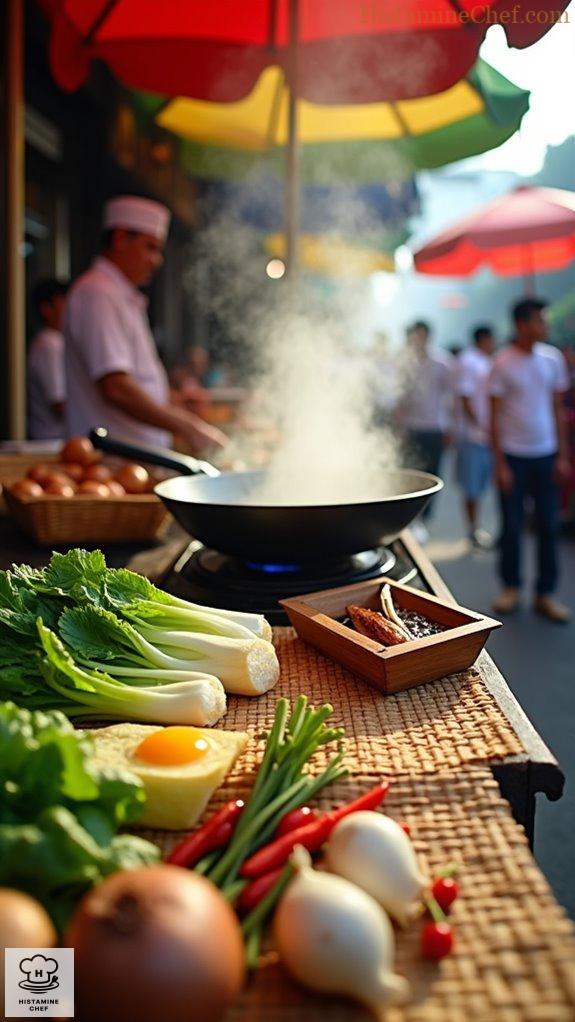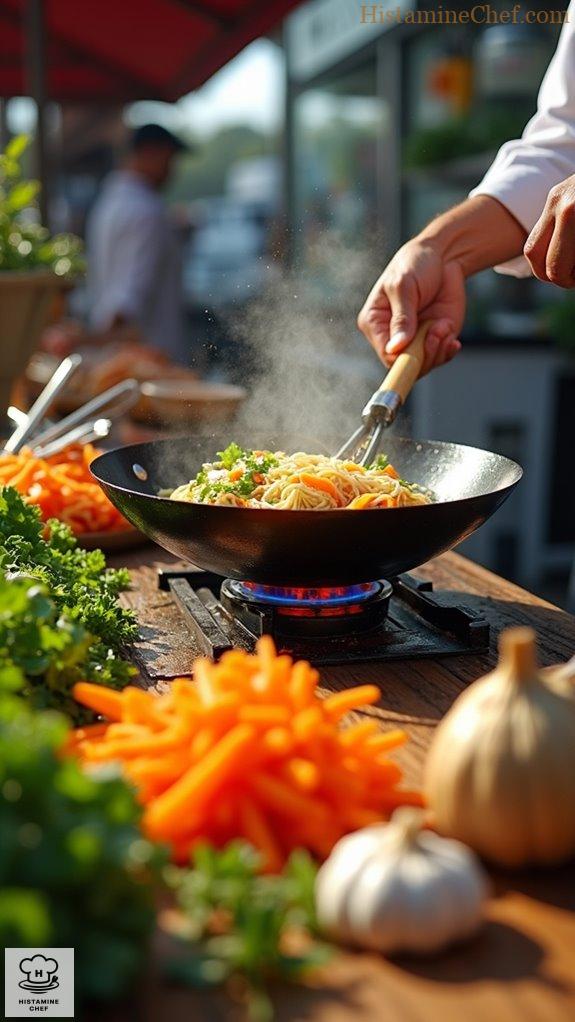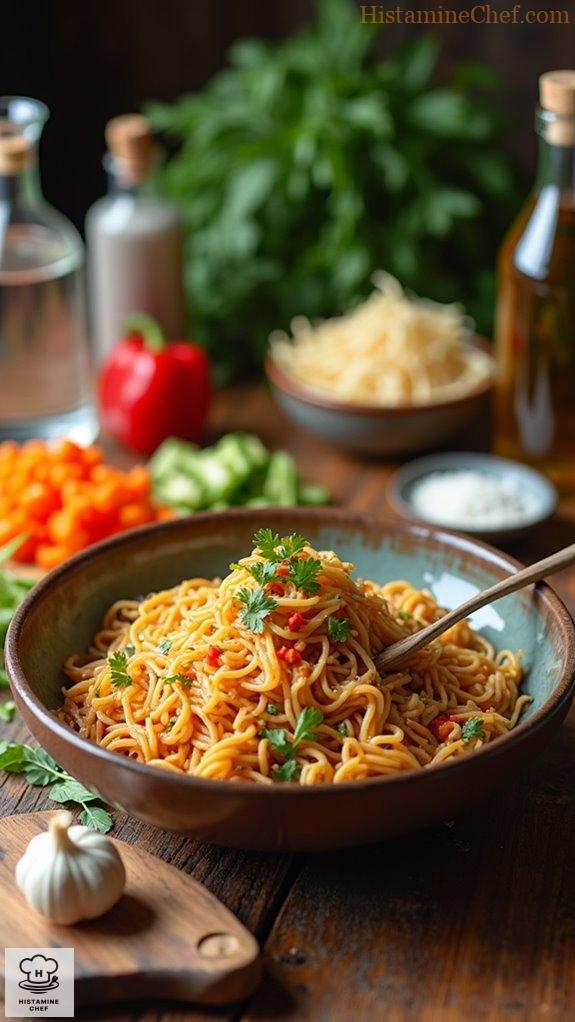Want to whip up a delicious Indonesian Mie Goreng that’s kind to your stomach? I’ve got you! Start by cooking rice noodles and sautéing fresh veggies like carrots and leafy greens in coconut oil at a high heat—yes, let’s get that wok sizzling! Instead of soy sauce, I use coconut aminos for a low histamine twist. Garnish with fresh herbs and enjoy! Curious about more tips and tricks for this mouthwatering dish? Stick around!
Jakarta’s Bustling Street Food Scene

Jakarta’s bustling street food scene is a vibrant tapestry of flavors and aromas, reflecting the diverse cultures and rich traditions of Indonesia. Street vendors, known as “penjual makanan,” line the crowded streets, offering an array of culinary delights that range from savory to sweet.
The history of street food in Jakarta dates back to the colonial era when hawkers sold simple meals to laborers and passersby. Over time, this practice evolved, becoming an integral part of the city’s socio-economic fabric.
Mie Goreng, a quintessential Indonesian dish, exemplifies this evolution, showcasing the fusion of Chinese and Indonesian cuisines. Traditionally stir-fried with a medley of vegetables and proteins, mie goreng is a demonstration of the resourcefulness of street vendors, who adapt flavors to suit local tastes while providing affordable meals.
As globalization intertwines with local traditions, Jakarta’s street food remains a beloved staple, celebrating both heritage and innovation.
Today, locals and tourists alike flock to these bustling food stalls, drawn by the allure of authentic taste and the communal experience that street food fosters in the heart of the metropolis.
Wok-Fried at High Heat

Street vendors prepare Mie Goreng by heating a large wok over high heat until it’s smoking.
They then add a generous amount of oil—usually a mix of coconut and extra virgin olive oil—for depth of flavor. Freshly cooked noodles are tossed in, followed by assorted chopped vegetables like carrots and leafy greens, ensuring everything is evenly coated in oil.
Vendors often add a signature blend of spices, such as garlic and ginger, stirring constantly to prevent sticking and burning. Finally, they finish the dish with a splash of soy sauce or a high-histamine alternative, mixing everything thoroughly before serving it hot, garnished with fresh herbs.
Ingredients:
- 300g fresh noodles
- 2 tablespoons coconut oil
- 1 cup sliced carrots
- 1 cup chopped leafy greens
- 1 tablespoon minced garlic
- 1 tablespoon minced ginger
- 2 tablespoons soy sauce or substitute
- Fresh herbs for garnish
Cooking Steps:
- Heat oil in wok over high heat.
- Add fresh noodles to the hot oil.
- Toss in sliced carrots and greens.
- Stir in minced garlic and ginger.
- Mix well to combine all ingredients.
- Add soy sauce (or substitute) to taste.
- Stir constantly to avoid burning.
- Serve hot, garnished with fresh herbs.
Homemade Mie Goreng Recipe

To prepare homemade Mie Goreng, start by cooking the noodles according to package instructions.
In a large skillet, heat coconut oil and sauté allowed vegetables such as carrots and bell peppers until tender.
Add the cooked noodles to the skillet, along with a splash of distilled white vinegar and a pinch of agave for sweetness.
Gently toss everything together and incorporate minced garlic for flavor.
Serve hot, and feel free to add protein such as chicken or quail eggs, ensuring all ingredients align with the SIGHI guidelines.
Changes for Homemade Mie Goreng:
- Use allowed vegetables only
- Replace traditional soy sauce with vinegar
- Substitute any restricted proteins
- Cook with coconut oil
- Add agave for sweetness
- Include minced garlic for flavor
- Serve without traditional spices or sauces
Low Histamine Variation of Mie Goreng

Histamine intolerance can make enjoying street food particularly challenging, as many popular street food dishes contain high-histamine ingredients. This poses a risk for individuals prone to histamine reactions, as the accumulation of histamine in the body can trigger various symptoms. Understanding the SIGHI list can help in identifying which street food ingredients are best to avoid. Foods tend to accumulate higher histamine levels when they are aged or improperly stored.
Eating street food like Mie Goreng can be problematic for those with histamine intolerance due to several restricted ingredients. Street food often contains fermented, processed, or long-fermented elements such as soy sauce, which are known to be high in histamine. Furthermore, the preparation and storage of these foods may lead to an increase in histamine levels, especially when the food isn’t made fresh.
According to the SIGHI list, components like fried noodles and certain vegetables featured in Mie Goreng can trigger adverse symptoms.
To prepare a low histamine variation of Mie Goreng at home, follow these steps:
- Use rice noodles instead of traditional egg or wheat noodles.
- Substitute soy sauce with a low histamine alternative like coconut aminos.
- Replace onions with fresh herbs for flavor, such as cilantro or basil.
- Avoid adding any pickled or tinned vegetables.
- Use fresh vegetables like carrots and bell peppers in moderation.
- Cook the dish using fresh, grilled chicken or duck instead of processed meats.
- Omit any fermented sauces or condiments while cooking.
- Use egg yolks instead of whole eggs if adding eggs.
- Opt for oils like coconut oil or olive oil for frying.
- Serve with fresh herbs or a squeeze of lemon for flavor enhancement.
Furthermore, using fresh ingredients and cooking methods that minimize histamine formation can contribute to a lower histamine content in your recipes.
Video Summary
Mie Goreng, or fried noodles, is a popular Indonesian street food beloved for its bold flavors.
Today, we’ll show the authentic street version first, followed by a home-friendly, lower histamine adaptation.
Street vendors start by boiling egg noodles until al dente. Then, they drain the noodles and set them aside.
In a hot wok, they heat vegetable oil, adding garlic and sliced onions. After sautéing until golden, they incorporate chopped vegetables like cabbage and carrots.
Next, the turkey or chicken is added, cooking until tender. Vendors pour in sweet soy sauce and a hint of chili sauce for flavor.
Stirring well, they mix in the noodles, allowing everything to meld. Finally, they garnish with fried shallots and serve it hot.
For a home lower histamine version, substitute with rice noodles instead of traditional egg noodles.
Use extra virgin olive oil instead of vegetable oil. Omit onions and chili sauce, using only a dash of salt instead.
Replace turkey or chicken with pure, fresh chicken. Include cabbage and carrots, but add zucchini for a fresh twist.
Skip the sweet soy sauce. Instead, mix honey with a small amount of distilled white vinegar to create a sauce.
Stir-fry all ingredients in a non-stick skillet or wok until everything is tender and well combined.
This delightful meal comes together beautifully, offering a comforting bowl full of flavor and warmth.
Click the link in the description for the full recipe!


Leave a Reply